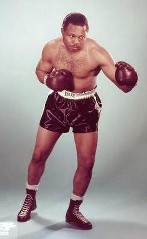By: Jim Amato

AUTHOR’S NOTE ; With the recent death of Canadian great Yvon Durelle I thought it would be fitting to post this article. Archie’s first fight with Durelle was surely a defining moment in both of their careers.
He was possibly the greatest light heavyweight of all time, The wily “Old Mongoose” Archie Moore. The man who scored 140 knockouts in a career that spanned from 1936 to 1963 never lost his crown in the ring. Although he unsuccessfully challenged twice for the heavyweight title, he did campaign successfully among the “Big Boys” throughout his tenure as a professional boxer. His record reads lie “Who’s Who” of boxing history. In 228 recorded bouts, Archie was only stopped seven times, a testimony to his courage and uncanny defensive ability.
Born on December 13, 1913, ( or 1916 to Archie) Moore boxed for years without due recognition. He fought all over the country. He even traveled to Australia and Argentina in search of fame and fortune. After six years on the circuit, Archie began to make his move toward the big time. In 1942, he knocked out Shorty Hogue in two rounds. Hogue had decisioned Archie no less than three times earlier in his career. He also beat rugged Jack Chase and drew with Ed Booker. In 1943, he won two out of three against Chase. In 1944, Moore lost by a knockout to Booker and also dropped a decision to the great Charley Burley. 1945 was a good year for Archie as he lost only two of fourteen fights. He beat Clevelander Lloyd Marshall twice. He was stopped by another Clevelander, the outstanding Jimmy Bivins. He lost a decision to Holman Williams but kayoed Holman in a rematch.
By this time Archie was formidable enough to warrant a title shot but it would be seven long years before he was granted one. Along the way, Moore would beat Curtis Sheppard twice and Bert Lytell twice. He would beat Bivins four times in rematches. He would defeat Harold Johnson in three put of four contests. He also scored victories over Ted Lowry, Bob Satterfield, Phil Muscato, Alberto Lovell and Jimmy Slade. The only boxer who could handle Archie was Ezzard Charles. Ezz beat Moore three times. The last time by a spectacular eighth round knockout in Cleveland. Finally on December 17, 1952, presumably just after his 39th birthday, Archie met yet another Cleveland legend, Joey Maxim. With Maxim’s world light heavyweight title on the line Archie won a persuading decision to become a champion at last.
As world champion the legacy of Archie Moore would flourish. He defeated Maxim twice in title rematches. He beat heavyweight Nino Valdes twice, Bob Baker and Bert Whitehurst. He would successfully defend his crown with knockouts over Harold Johnson and Bobo Olson. On September 21, 1955, Archie would get his first crack at the heavyweight crown when he met Rocky Marciano. In the second round Archie sent Marciano to the canvas. Rocky beat the count and lasted out the round. Slowly the tide turned in Marciano’s favor. Rocky proved to be too strong for the gritty Moore who finally succumbed in round nine. He kayoed Yolande Pompey in a title defense and on November 30, 1956, he was matched with Floyd Patterson for the heavyweight championship that Marciano had vacated. Although Archie was given a good chance to win by experts the youthful Patterson was much too fast and stopped Moore in round five.
Archie went back to defending his light heavyweight crown stopping the highly regarded Tony Anthony in seven rounds. Moore continued to meet heavyweights in hope of securing one more shot at that title. Archie defeated Howard King twice, Roger Rischer, Willi Besmanoff and Charley Norkus before putting his title on the line. Moore’s 1958 bout with Canada’sYvon Durelle secured Archie’s place in fistic history. Repeatedly knocked down in the early rounds and then down again in the fifth, Moore refused to surrender. By the middle rounds Durelle began to tire. Archie came on to stop Durelle in the eleventh round to retain his title in a classic thriller. In their 1959 rematch Yvon was a lot less troublesome as he exited in round three. Moore did not defend his title at all in 1960 much to the dismay of the National Boxing Association who withdrew recognition of Archie as a champion on October 25th. Old foe Harold Johnson beat Jesse Bowdry to claim the vacant NBA title. Still recognized be New York State and the European Boxing Union Archie decisioned Giulio Rinaldi in his final title defense.
On February 10, 1692, New York and the EBU stripped Archie of his crown. A feat no mere mortal could accomplish in the ring. Finally the ageless wonder began to slow down. Archie still had enough left in 1962 to draw the future protege Cassius Clay. Clay had won the light heavyweight Gold Medal at the 1960 Olympics and had trained briefly under Archie early in his pro career. The brash upstart overwhelmed the aging warrior as he had predicted in round four. Archie had no more illusions of becoming heavyweight champion.
Upon his retirement, Archie did some acting and he also became very involved in helping the youth of America. He started a program called “Any Boy Can” and used this as a vehicle to reach young people in a positive manner. Archie’s book which is aptly titled “Any Boy Can” explains Archie’s views on helping youth as well as Archie covering his life and boxing career.

